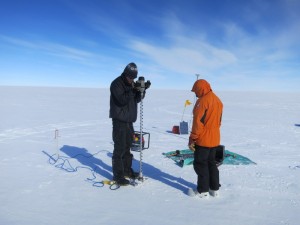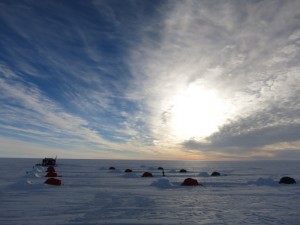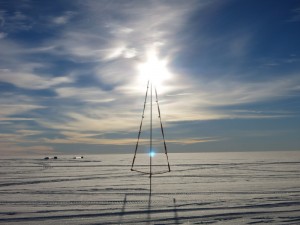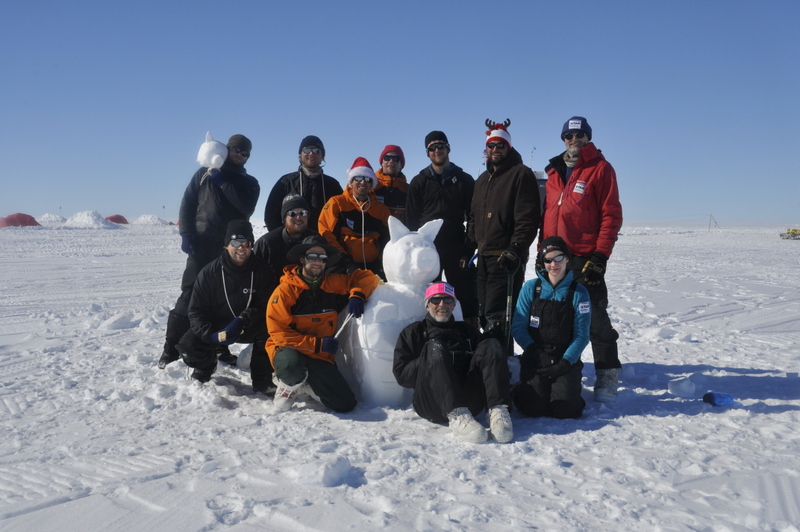
Jan De Rydt
The update below has just arrived from BAS glaciologist Jan De Rydt, who is participating in the iSTAR traverse. All members of iSTAR, in Antarctica, the UK, and further afield, would like to wish our readers a very happy New Year!
We can see mountains on the horizon! Or are they just mountain-shaped clouds? After many weeks on the ice plains of Pine Island Glacier, our eyes sometimes deceive. However, whilst driving one of many radar lines away from camp, Damon pointed his camera north yesterday, and took a picture of dark silhouettes rising from the flat surface, with clouds draping the peaks – they must be the Hudson Mountains! Though almost 100 km away, and situated on the other bank of this mighty river of ice, we are currently camped at an elevation of 750 m, and catching a glimpse of this range is not entirely implausible. However, this is not the only topography around! Deep beneath our feet, and covered by ice up to 2.5 km thick, another intricate landscape of rock and sediment is hidden. A lot of the work we do is intended to reveal the secrets of this mountainous landscape, and to understand how the ice flows over this part of the Antarctic continent.
During the last few weeks, a lot of progress has been made. Pine Island Glacier has treated us with an exceptionally long and continuing period of good weather, and since our last update, the iSTAR traverse has moved an astonishing 400 km, delivering an amazing amount of science along the way. From camp 8, we continued our way up onto one of Pine Island’s several tributaries, and we reached the most northerly point of the traverse on 16 December. After a one-night stop, our train travelled south again in a big loop, which took us back through an earlier site, announced by the appearance of deserted flags and a maze of skidoo tracks in the mist. Along the way, setting up camp has turned into a very efficient routine, and at each stop the otherwise so quiet and regular landscape turns into a buzzing and colourful little village. Our living container on skis (‘home sweet home’) is positioned in the centre of the camp, flanked by 12 sleeping tents on one side, and a line of science tents and sledges with equipment and fuel on the other side. Soon everyone starts to offload boxes, Tim takes pride in digging a big hole next to the caboose for Anna’s radar work, science areas are marked with flags, the Pistenbully’s are parked facing the wind, and somebody makes sure the kettle is on.

An auger is used to drill a hole through the ice for the neutron probe, which is used to measure snow density. Photo: Jan De Rydt.
At some stops, we stay for only one night, which gives Peter enough time to complete the drilling and probing of a 15 m deep hole to monitor the density of the upper ice layers. At the larger sites, we usually camp 3 nights, allowing time for Thomas, Rob, Steph, Damon and David to drive several hundreds of kilometres of radar lines that will reveal in great detail the upper stratigraphy of the ice as well as the bed topography. And whilst everyone is working long days and nights to complete the work, Pine Island Glacier never ceases to amaze. We have seen beautiful miniature icy landscapes, scoured by the wind like dunes; diamond dust has filled the sky like twinkling stars; rivers of drifting snow have covered and shaped the surface; we have watched the most magnificent halos; and during the night, when the sun approaches its lowest point, clouds have displayed a colourful array of yellows and greys and blues. Several times we were visited by birds, curious Antarctic skuas accompanied us for a while, but also the motorized type came flying past – a BAS Twin Otter! Seeing the red miniature plane appear at the horizon, and hearing the distinct noise of its two props is a special experience in this remote place. The plane delivered some items from our shopping list which was sent to Rothera a while before, and after refueling, we waved goodbye as it continued its journey to other remote places.
For long we were trying to guess where we would be on Christmas day – the star turned out to point to site 15. And when most of the science ended during the late hours on Christmas eve, it was decided to stay for a bit longer to enjoy a relaxed day. We woke up to see a beautiful Christmas tree had grown next to camp overnight – courtesy of David and a collection of fine tools found around here: a glacial pole, bamboo, a ratchet strap and rope. 11 little bags with chocolate coins formed a tasty decoration, and Anna added a lovely present for each of us. The weather was absolutely brilliant, and whilst we imagined everyone at home would be gathered around the fireplace, we decided to have afternoon Christmas dinner outside in the sun! Peter and Damon skilfully carved, chopped and shovelled benches and leg space out of the snow, and the surface of Pine Island Glacier transformed into the finest table in its history. Comfortably seated on sheep skins and tucked into our warm jackets, we enjoyed James’ and Jonny’s amazing Christmas special, which ended in a sugar explosion of crumble, mince pie and fruit cake with a specially designed iSTAR traverse topping. It was the perfect prelude for a sweet (or cheesy) evening watching the Muppets and their Christmas carols.
Since Christmas, we have finished work at two more sites, and tomorrow we move to number 18 out of 22. It means that for some of us, this season is rapidly coming towards an end, and from now on, we will occasionally talk about making the long journey back to Rothera. But before that, we know that Pine Island Glacier has many more exciting things for us to uncover, and there will be plenty more memorable moments, including the start of a new year! From this very special place at 75 degrees south, we would like to wish everyone a very happy and inspiring New Year, and we hope to see you soon in 2014!



